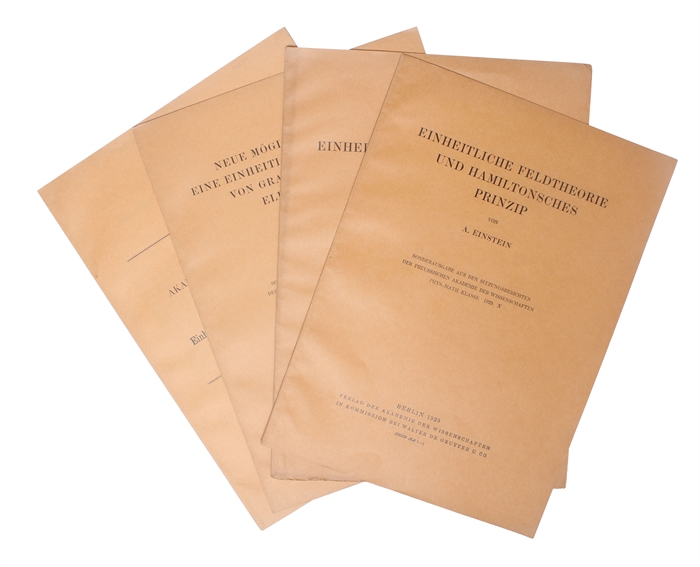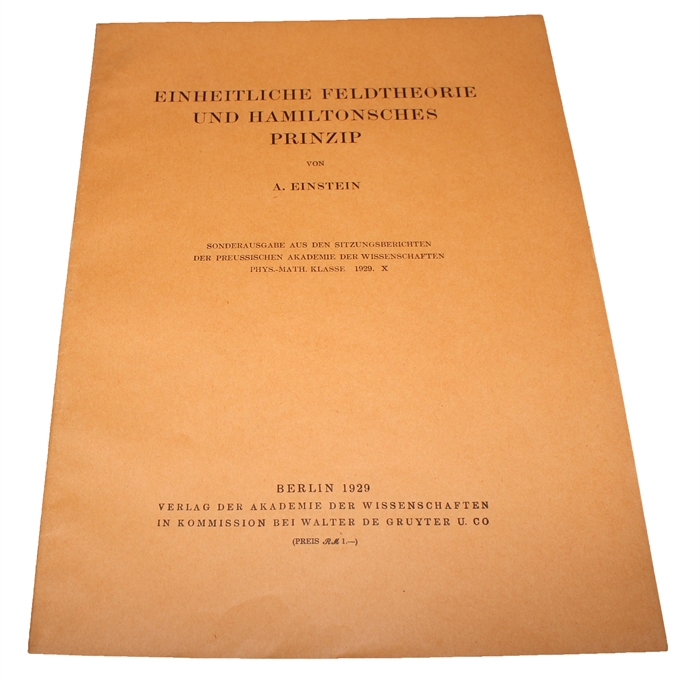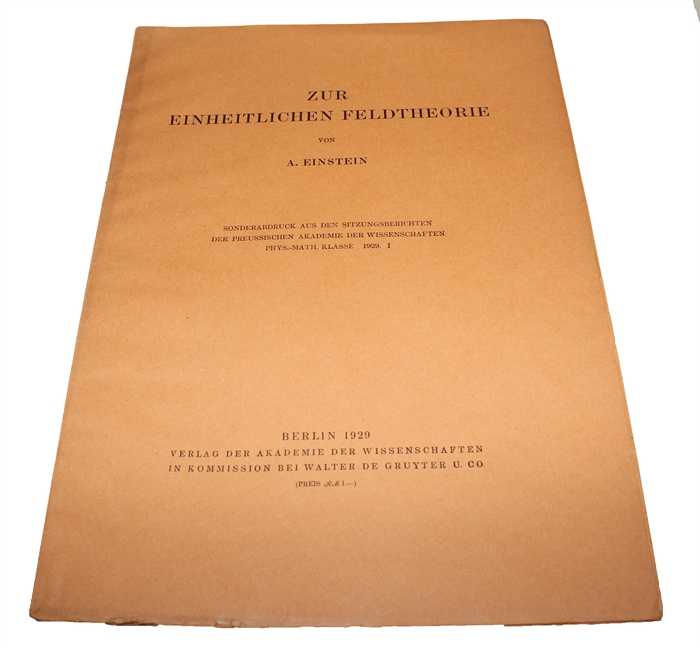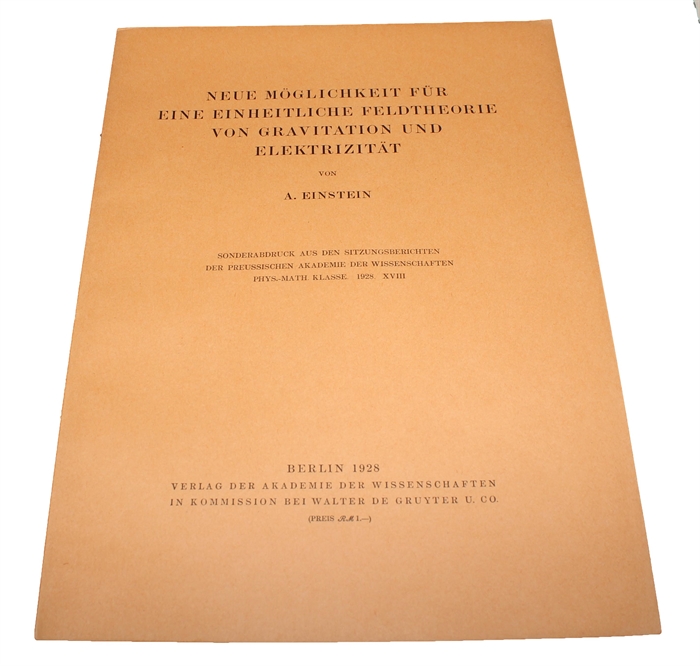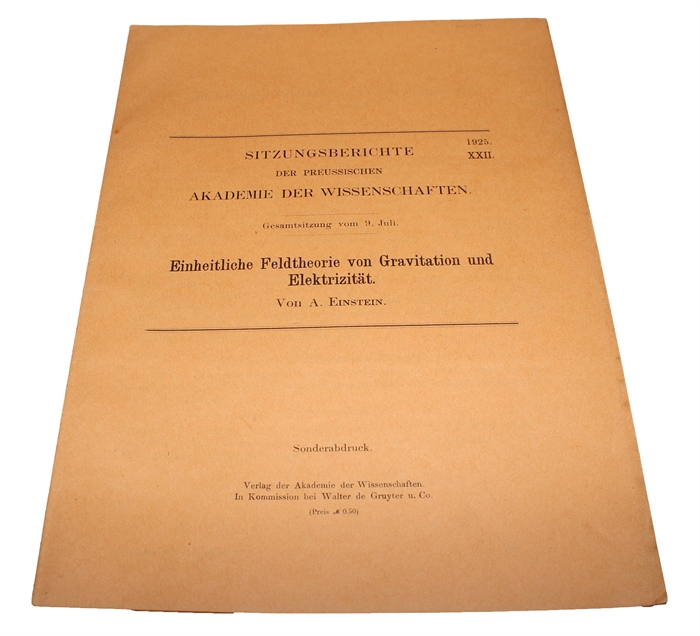PMM 416 - A NEW THEORY OF GRAVITATION
EINSTEIN, ALBERT.
Einheitliche Feldtheorie von Gravitation und Elektrizität (+) Neue Möglichkeit für eine einheitliche Feldtheorie von Gravitation und Elektrizität (+) Zur einheitlichen Feldtheorie (+) Einheitliche Feldtheorie und Hamiltonsches Prinzip (+) Über den gegenwärtigen Stand der Feldtheorie.
Berlin, Königlich Akademie der Wissenschaften, 1925-1929.
1. Einheitliche Feldtheorie von Gravitation und Elektrizität. Offprint: S. B. preuss. Akad. Wiss., 1925, pp.414-419. Original wrappers. Mint. (Weil 147 / Boni 155).
2. Neue Möglichkeit für eine einheitliche Feldtheorie von Gravitation und Elektrizität. Offprint: S. B. preuss. Akad. Wiss., 1928, pp.235-245. Original wrappers. Mint. (Weil 162/ Boni 175).
3. Zur einheitlichen Feldtheorie. Offprint: S. B. preuss. Akad. Wiss., 1929, pp.2-7. Original wrappers. Mint. (Weil 165/ Boni 183).
4. Einheitliche Feldtheorie und Hamiltonsches Prinzip. Offprint: S. B. preuss. Akad. Wiss., 1929, pp.156-159. Original wrappers. Mint. (Weil 166/ Boni 184).
5. Über den gegenwärtigen Stand der Feldtheorie. In: Festschrift Dr. A. Stodola, Zürich, Füssli, 1929, pp.126-132. Publishers full cloth. Spine slightly faded. Otherwise mint. (Weil 168 / Boni 178).
All in all a very fine set.
Offprint of all four papers and first edition of the final essay, constituting Einstein's attempt toward creating a unified field theory: "a new theory of space with a view to unification of all forms of activity that fall within the sphere of physics, giving them a common explanation" (PMM416). The task of unifying nuclear, electromagnetic, and gravitational force is nowadays by many considered the holy grail of theoretical physics.
Maxwell was the first to develop such a theory when he described the forces of electricity and magnetism as the single force electromagnetism. After Einstein had completed his general theory of relativity (a field theory for gravitation), he turned his attention towards generalizing his theory even further to include Maxwell's theory. Even though Einstein never succeeded in completing this task, in the way that he finished his earlier theories, he pioneered and explored many areas of this subject.
"It had been repeatedly observed that Einstein's general theory of relativity necessitated a pluralistic explanation of the universe. In 1925 he announced that he had resolved this difficulty but the announcement was premature. In 1928 he attacked the problem once more, only to find that Riemann's conception of space, on which the general theory was based, would not permit of a common explanation of electromagnetic and gravitational phenomena. In a series of papers [the present] devoted to the development of 'A Uniform Theory of Gravitation and Electricity' he outlined a new theory of space with a view to unification of all forms of activity that fall within the sphere of physics, giving them a common explanation. All that would then remain to complete a scientific unison is the correlation of the organic and inorganic".
PMM 416
Barchas 586
Order-nr.: 52559

